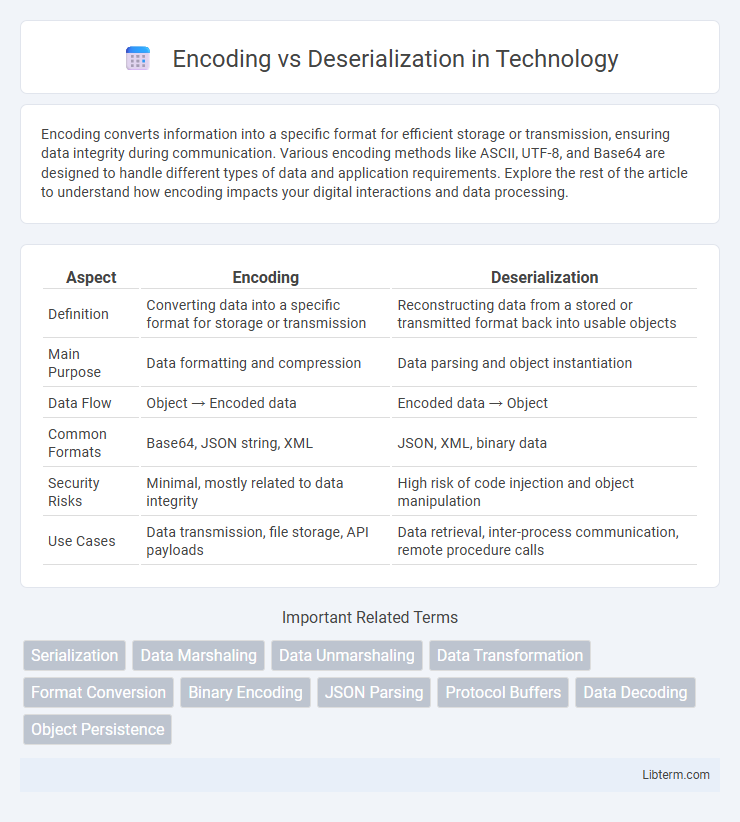Encoding converts information into a specific format for efficient storage or transmission, ensuring data integrity during communication. Various encoding methods like ASCII, UTF-8, and Base64 are designed to handle different types of data and application requirements. Explore the rest of the article to understand how encoding impacts your digital interactions and data processing.
Table of Comparison
| Aspect | Encoding | Deserialization |
|---|---|---|
| Definition | Converting data into a specific format for storage or transmission | Reconstructing data from a stored or transmitted format back into usable objects |
| Main Purpose | Data formatting and compression | Data parsing and object instantiation |
| Data Flow | Object → Encoded data | Encoded data → Object |
| Common Formats | Base64, JSON string, XML | JSON, XML, binary data |
| Security Risks | Minimal, mostly related to data integrity | High risk of code injection and object manipulation |
| Use Cases | Data transmission, file storage, API payloads | Data retrieval, inter-process communication, remote procedure calls |
Introduction to Encoding and Deserialization
Encoding transforms data into a specific format for efficient storage or transmission, using methods like Base64, JSON, or XML encoding. Deserialization reverses this process by converting encoded data back into its original object or format, enabling applications to reconstruct and utilize the transmitted information. These processes are essential in data exchange, facilitating interoperability between different systems and ensuring data integrity during communication.
Defining Encoding: Purpose and Applications
Encoding transforms data into a specific format for efficient storage, transmission, or processing, ensuring compatibility across different systems. It is widely used in applications such as data compression, communication protocols, and multimedia streaming to optimize resource usage and maintain data integrity. Common encoding methods include Base64 for email transmission and UTF-8 for text representation in web development.
Understanding Deserialization: Key Concepts
Deserialization is the process of converting encoded data back into its original object or data structure, enabling programs to reconstruct complex data from a byte stream or string format. Unlike encoding, which transforms data into a format suitable for storage or transmission (such as JSON or XML), deserialization interprets this format to restore the data's usability in software applications. Understanding the security implications of deserialization is crucial, as improper handling can lead to vulnerabilities like remote code execution or data tampering in serialized object streams.
How Encoding Works in Data Processing
Encoding in data processing transforms information into a specific format using algorithms such as Base64 or UTF-8 to ensure compatibility and efficient storage. This process converts raw data into a standardized byte stream, enabling secure transmission and reducing errors across systems. Effective encoding maintains data integrity by preserving the original structure while optimizing for speed and compression.
The Deserialization Workflow Explained
The deserialization workflow converts serialized data formats like JSON, XML, or binary back into usable objects or data structures in programming. During this process, the system interprets the encoded byte stream, reconstructing the original data types, properties, and object relationships to restore the state accurately. This workflow typically involves parsing the input, validating the schema, and instantiating corresponding objects, ensuring data integrity and security against deserialization attacks.
Encoding vs. Deserialization: Core Differences
Encoding transforms data structures or object states into a format suitable for storage or transmission, such as JSON or XML, enabling efficient data exchange. Deserialization reverses this process by converting encoded data back into usable objects or data structures within a program. The core difference lies in encoding preparing data for transfer or storage, while deserialization restores that data to its original form for application use.
Common Use Cases for Encoding
Encoding transforms data into a specific format for efficient storage, transmission, or compatibility with different systems, commonly used in web development for URL encoding and Base64 encoding for embedding images in HTML or JSON. It ensures safe data exchange over networks by converting special characters and binary data into text formats, preventing corruption or misinterpretation. Common use cases include encoding data for APIs, email, data compression, and cryptographic applications.
Practical Applications of Deserialization
Deserialization transforms data from formats like JSON, XML, or binary into usable objects, enabling seamless integration between systems, databases, and APIs in software development. It plays a critical role in practical applications such as restoring persisted states, processing data from external sources, and facilitating communication in distributed systems. Effective deserialization ensures data integrity and type safety, enhancing application reliability and performance.
Security Implications: Risks in Encoding and Deserialization
Encoding transforms data into a specific format to ensure safe transmission or storage but does not inherently provide protection against malicious content. Deserialization, which reconstructs data objects from encoded formats, poses significant security risks such as code injection, remote code execution, and data tampering when untrusted or improperly validated input is processed. Secure deserialization practices include strict validation, using safe libraries, and avoiding deserialization of untrusted data to mitigate vulnerabilities exploited in cyberattacks.
Choosing the Right Method: Best Practices and Recommendations
Choosing between encoding and deserialization depends on the specific use case, data format, and security requirements. Encoding is best suited for data transmission and storage as it converts data into a standard format like JSON or Base64, ensuring compatibility and preventing data corruption. Deserialization should be handled cautiously to avoid security vulnerabilities, with best practices including validating input data, using secure libraries, and avoiding deserializing untrusted sources.
Encoding Infographic

 libterm.com
libterm.com